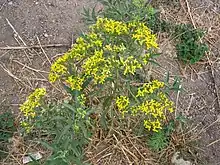| Barkleyanthus | |
|---|---|
 | |
| Scientific classification | |
| Kingdom: | Plantae |
| Clade: | Tracheophytes |
| Clade: | Angiosperms |
| Clade: | Eudicots |
| Clade: | Asterids |
| Order: | Asterales |
| Family: | Asteraceae |
| Subfamily: | Asteroideae |
| Tribe: | Senecioneae |
| Genus: | Barkleyanthus H.Rob. & Brettell |
| Species: | B. salicifolius |
| Binomial name | |
| Barkleyanthus salicifolius (Kunth) H.Rob. & Brettell | |
| Synonyms[2] | |
| |
Barkleyanthus is a monotypic genus[3] of flowering plants in the aster family, Asteraceae, containing the single species Barkleyanthus salicifolius, a plant formerly classified in the genus Senecio.[4][5][6] It is native to North and Central America, where its distribution extends from the southwestern United States to El Salvador.[5] Its common names include willow ragwort,[6] willow groundsel, Barkley's-ragwort,[1] and jarilla.[3]
This plant is a shrub producing a branching stem usually about one to two meters tall, but known to exceed 4 meters at times. The leaves are roughly lance-shaped and are alternately arranged, sometimes more densely toward the ends of branches. They are up to 10 or 15 centimeters long. The inflorescence is often a wide array of several flower heads, but they may also be clustered in the leaf axils or branch tips. The head contains a few yellow ray florets, which are pistillate, and up to 25 or more yellow disc florets, which are bisexual. The fruit is a rough-textured, pyramidal or prism-shaped cypsela up to a centimeter long including its pappus of many barbed white bristles.[4]
This plant is abundant in parts of its range, particularly in Mexico, sometimes becoming weedy.[4] It flowers year-round, especially in spring,[4] and it may be in full flower at the end of the dry season.[3] It is admired for its yellow flower heads and is cultivated as an ornamental plant.[3][4]
The plant is used in Mexican traditional medicine to treat fever and rheumatism.[7] In Chiapas it is used as an insecticide in corn supplies.[7] Secondary metabolites isolated from the species include pyrrolizidine alkaloids, lactones, furoeremophilanes, and sesquiterpenes.[7]
References
- 1 2 Barkleyanthus salicifolius. NatureServe. 2013.
- ↑ "Barkleyanthus salicifolius". Plants of the World Online. Royal Botanic Gardens, Kew. 2022. Retrieved 2022-03-29.
- 1 2 3 4 de Vivar, A. R., et al. (2007). Secondary metabolites from Mexican species of the tribe Senecioneae (Asteraceae). Archived 2014-10-21 at the Wayback Machine Revista de la Sociedad Química de México 51(3), 160-72.
- 1 2 3 4 5 Barkleyanthus salicifolius. Flora of North America.
- 1 2 "Barkleyanthus salicifolius". Germplasm Resources Information Network. Agricultural Research Service, United States Department of Agriculture. Retrieved 21 January 2018.
- 1 2 Barkleyanthus salicifolius. Integrated Taxonomic Information System (ITIS).
- 1 2 3 González, C. P., et al. (2013). Anti-inflammatory activity and composition of Senecio salignus Kunth. BioMed Research International 2013.
